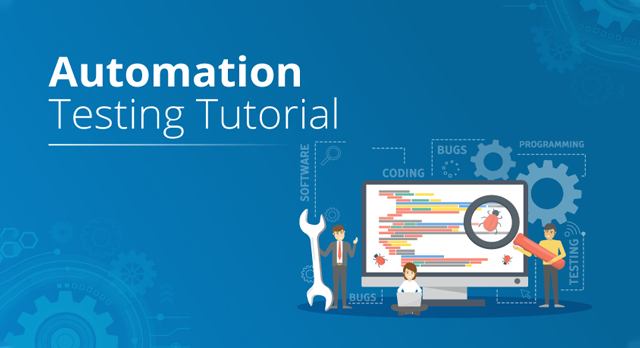Exploring the Future of Automation Testing in Software Application Development
Exploring the Future of Automation Testing in Software Application Development
Blog Article
From Guidebook to Automated Screening: A Comprehensive Guide to Transitioning Efficiently and Successfully
In the realm of software screening, the shift from guidebook to automated procedures has actually become an increasingly vital transition for organizations seeking to improve performance and precision in their testing techniques. As technology remains to development, the demand for seamless and efficient automatic screening techniques has never been much more pressing. The trip from handbook to automated testing is not without its obstacles, but when come close to purposefully and with a clear strategy in mind, the benefits can be substantial - automation testing. In this detailed overview, we will explore vital actions and considerations vital for a successful transition, from the preliminary choice of devices to the assimilation of automation into existing workflows. Keep tuned to reveal the insights that will assist lead the way for a smoother and much more reliable screening procedure.
Benefits of Automated Checking
Automated testing offers countless benefits, boosting performance and accuracy in software application growth procedures. Automated tests can be run at the same time on numerous gadgets and running systems, considerably speeding up the screening phase contrasted to manual testing.
In addition, automated testing makes sure a greater degree of accuracy in finding issues. Considering that automated examinations follow predefined manuscripts, human error is minimized, bring about even more trusted examination outcomes. Uniformity in testing is likewise enhanced, as automated tests carry out the exact same steps precisely each time they are run. This uniformity is crucial in ensuring that all functionalities of the software program are extensively checked, minimizing the possibility of undetected pests sliding with to production.
Choosing the Right Tools

First of all, examine your objectives and requirements. Recognize the extent of your project, the modern technologies entailed, and the capability of your team. This evaluation will certainly assist you figure out the functions and abilities you require in your screening devices.
Secondly, consider the compatibility of the devices with your existing systems and procedures. Seamless assimilation with your present software application development lifecycle is necessary to ensure a smooth transition to automation.
In addition, assess the scalability and flexibility of the devices. As your testing requires progress, the tools need to have the ability to adapt and suit adjustments successfully.
Lastly, variable in the support and area around the tools. Durable support and an energetic individual community can give useful resources and aid when executing automated screening. By meticulously thinking about these facets, you can select the right devices that align with your demands and established the stage for an effective transition to automated testing.
Writing Reliable Examination Manuscripts

When crafting test scripts, it is vital to take into consideration the certain needs of the software application being tested and make sure that the scripts attend to all crucial capabilities. Clear and descriptive calling conventions for test manuscripts and examination cases can improve readability and maintainability. Additionally, integrating mistake handling mechanisms within the test manuscripts can aid in identifying and attending to concerns quickly.
Moreover, arranging test scripts right into modular parts can improve reusability and scalability, lowering redundancy and enhancing effectiveness in examination manuscript maintenance. Routine evaluations and updates to test scripts are vital to maintain pace with developing software application needs and capabilities. By following these principles, testers can produce reliable and durable examination scripts that contribute substantially to the success of automated screening procedures.
Integrating Automation Into Workflows
Effective assimilation of automation devices right into existing operations improves processes and improves performance within software development cycles. When incorporating automation right into operations, it is critical to recognize recurring jobs that can be automated to save time and minimize human error. By perfectly incorporating automated testing tools like Selenium or Appium into the software program growth lifecycle, groups can achieve faster comments on code adjustments, resulting in quicker pest detection and resolution. This integration enables constant screening throughout the advancement procedure, ensuring that any issues are recognized beforehand, causing higher software quality. In addition, automation can be utilized to set off examinations instantly after each code dedicate, providing prompt validation and maximizing testers to concentrate on more complex circumstances. Appropriate integration of automation devices needs collaboration in between development, screening, and operations teams to develop a unified workflow that maximizes effectiveness and performance in supplying high-quality software.
Guaranteeing a Smooth Transition
Effectively transitioning see this website to automated screening involves careful preparation and mindful execution to lessen disturbances and make the most of efficiency in the software application advancement procedure - automation testing. To ensure a smooth transition, it is necessary to start by carrying out a thorough assessment of the current testing processes and identifying areas where automation can bring the most significant benefits. Engaging with all stakeholders early on in the process, consisting of designers, testers, and job supervisors, is important for garnering support and buy-in for the automation effort
Interaction is key during this transition stage. Clear interaction of the goals, advantages, and expectations of automated testing aids to take care of any type of resistance or worries that may develop. In addition, supplying ample training and resources for staff member to upskill in automation devices and techniques is essential for guaranteeing an effective transition.

Conclusion
Finally, transitioning from handbook to automated testing supplies numerous advantages, consisting of enhanced effectiveness and integrity. By choosing the proper devices, writing efficient test manuscripts, and integrating automation effortlessly right into operations, companies web link can guarantee a effective and smooth shift. It is necessary to embrace automation as a valuable property in software program screening processes to enhance overall high quality and efficiency.
In the realm of software program testing, the change from handbook to automated processes has actually ended up being a significantly crucial change for organizations looking for to improve performance and precision in their screening techniques. Automated examinations can be run concurrently on several tools and running systems, drastically speeding up the testing phase compared to manual screening. Consistency in screening is also enhanced, as automated tests perform the very same actions exactly each time they go to these guys are run.To ensure the successful implementation of picked screening devices, the creation of efficient examination manuscripts plays a vital role in verifying the capability and efficiency of automated processes - automation testing. By complying with these concepts, testers can develop robust and efficient examination manuscripts that contribute significantly to the success of automated testing processes
Report this page